|
|
Post by Arjan Hut on Mar 13, 2019 13:06:26 GMT -5
65 Repair ticket 18374
Compare:12 The identity of the reporter asking the Walker-question on 23-11-1963
39 G. Wray Gill's November 1963 office phone bill48 Ruth Paine's handwritten draft of the 'Comrade Kostin' letter to the Soviet EmbassyThe repair ticket, bearing the number 18374 and made out to a customer named "Oswald," which the Irving gunsmith (Dial Ryder) produced from his records. Unless and until the police produce this other "Oswald" with his rifle and the telescopic sight fitted by the gunsmith, the ticket is hard evidence of a plot. (Joachim Joesten, Oswald- Assassin or Fall Guy? p. 121)  211 or 212 Irving Boulevard area today 211 or 212 Irving Boulevard area todayRyder had become known to the Dallas police on Sunday, November 24, 1963 (a few hours after Oswald was shot to death) as the result of an anonymous telephone call to a television newscaster informing him that Oswald had had a rifle sighted on Thursday, November 21, at a gun shop at 211 or 212 Irving Boulevard in Irving, Texas. The police had located the owner, Charles Greener, and his employee Ryder. According to Detective F. M. Turner's report: He [Greener] states that he and Ryder have talked about this and have seen
photos of Oswald and photos of the gun in the paper and neither can remember
doing any work for this man, or any work on this gun. He will
check his files for names and call back if he finds anything. He states that
another reason that both of them think that they never worked on this gun
is that in the photo the screws that hold the clamp that holds the scope on
the rifle look like they are on top of the gun, and he thinks that neither of
them ever saw a gun with a scope mounted with these screws on top.
On November 28, 1963, I talked to Mr. Greener again. He states they
found a work ticket back in the rear of the shop. This ticket has no date on
it, but the best they can figure out this work probably came in November 4
to November 8, 1963. This ticket has the name Oswald on it. . . . Neither
he nor Ryder can remember the face, or doing any work for this man. . . .
We talked to Mr. Dial D. Ryder. . . . He states that he wrote the work
ticket up with the name Oswald on it. We showed him a new mug shot of
Oswald, and he states that he cannot identify the man as the one who left
a rifle with him. (CE 2003, pp. 252-254) Not a word of this appears in the Warren Report, nor is the police report even cited in the footnotes. Instead, the Report tells us: The authenticity of the repair tag bearing Oswald's name is indeed subject
to grave doubts. Ryder testified that he found the repair tag while cleaning
his workbench on November 23, 1963. However, Ryder spoke with Greener
repeatedly during the period between November 22-28 and, sometime prior
to November 25, he discussed with him the possibility that Oswald had been
in the store. Neither he nor Greener could remember that he had been. But
despite these conversations with Greener, it is significant that Ryder never
called the repair tag to his employer's attention. Greener did not learn about
the tag until November 28, when he was called by TV reporters. . . .
Subsequent events also reflect on Ryder's credibility. (WR 315-316) That is a slanted account of what had happened. On Sunday, November 24 Greener himself had promised "to check his files" for any record of Oswald. Neither he nor Ryder remembered or identified Oswald. And Greener didn't believe for a minute that Ryder had fabricated the repair tag. He said: Greener: I have confidence in the boy, or I wouldn't have him working for me.
Liebeler: You don't think he would make this tag up to cause a lot of commotion?
Greener: I don't think so. He doesn't seem like that type boy. I have lots of
confidence in him or I wouldn't have him working for me and handling
money. Especially times I am going off. He—if he wasn't the right kind of
boy, and he pretty well proved that he is by dependability and in all relations
that we have together, and I just don't figure that is possible.(11H 249) The Commission nevertheless decided to impeach Ryder's character on the basis of inconsequential discrepancies in what Ryder said to a reporter and an investigator—as well as the character of one of the two witnesses acknowledged by the Report to provide "possible corroboration" for his story. (WR 316) (Sylvia Meagher, Accessories after the fact, p. 367-368)  The FBI neither asked Ryder for the name and address of the man who brought in the Argentine rifle, nor did they review the shop's repair tickets, nor did they make any attempt to learn if the individual ever existed. NOTE: The owner of the Irving Sports Shop, Mr. Charles W Greene, telephoned all of the Oswalds listed in the Dallas and Irving telephone directories in an attempt to locate the "Oswald" listed on repair ticket 183 7 4, but was unsuccessful. (John Armstrong, Harvey & Lee, p. 459)  (1968 article, with Charles Greener (2nd left) and Dial Ryder (3rd right), thanks to Jessica Shores) (1968 article, with Charles Greener (2nd left) and Dial Ryder (3rd right), thanks to Jessica Shores)
|
|
|
|
Post by Arjan Hut on Mar 15, 2019 13:10:41 GMT -5
66 The original and complete Alyea Film
Related:16 The camera original of the Nix film19 The Pitzer Film21 Several frames from the Towner film30 The original Wiegman film31 The original Darnell film32 Unseen Darnell footage33 The Cook film
91 Record of Ellsworth questioning Oswald
Erasing the Past...DiscussionsMR. GUNN: Q: Look at the next one on the list, please, the Thomas Alyea film. What is the earliest generation copy that you have of the Alyea film? A: I don’t know. I had a multi-generation copy, which was rather contrasty. And I don’t have any idea what the source was. It was much later than the original. Q: Have you ever had access to an earlier source? A: Not that I’m aware of. I’ve seen- I have seen Alyea footage-earlier prints that I did not have access to, which had footage that I had never seen before. But it was definitely his film. Q: Okay. We’d like you to bring that-your earliest generation of the Alyea film, as well. Have you ever seen the original Alyea film? A: The camera original? Q: Camera original. A: Not that I’m aware of, no. (Robert Groden, ARRB deposition, 1996) WFAA-Reporter Tom Alyea was one of the first people to reach the 6th floor of the Texas School Book Depository. Alyea was one of the people to see the 6th floor as it was left behind by the shooter(s). The reporter managed to get his film out of the depository by throwing it down to a colleague on Elm Street. The original and complete film vanished. Only some incomplete fragments remain. (Flip de Mey, Cold Case Kennedy, p. 186/187)  Tom Alyea interviewed in front of the book depository in 1964. Tom Alyea interviewed in front of the book depository in 1964.
The Warren Committee showed no interest in his footage and he was not asked to testify.
|
|
|
|
Post by Arjan Hut on Mar 15, 2019 14:00:04 GMT -5
67 Bob Jackson’s Houston Street PictureOne photograph taken by Dallas Times Herald photographer Bob Jackson was so obviously in opposition to the official police position that it was suppressed by late 1966. Jackson was riding in one of the news photographer’s cars in the motorcade with Dallas Morning News photographer, Tom Dillard. As Jackson’s car approached the Depository building and travelled north on Houston Street, between Main Street and Elm Street, Jackson snapped a picture. At the time, the Kennedy car was already on Elm Street and was probably close to the position where the first shot was fired. Jackson’s car was eight cars behind Kennedy’s (about twenty car lengths). Jackson can be seen taking this picture in the Robert Hughes film and in some of the TV footage taken by other photographers. He also testified that he took the picture. When the author asked Masiotta about the Jackson photo in early 1967, he became very flustered and claimed to know nothing about it. Jackson himself was finally located and, when asked about it, became very angry and denied taking a picture. That photograph has never been seen by anyone outside of the Times Herald staff. It’s not difficult to speculate about what it probably showed, since the Hughes film, the Weaver photo, the Dillard photo and the Tom Alyea TV sequence all show the same thing. Jackson’s photo, without doubt, showed "Oswald’s window" in the Depository building empty when Oswald should have been in it—an embarrassing counterpoint to Jackson’s testimony that he saw someone in that window with a rifle. If Jackson’s photo (or anyone else’s for that matter) showed Oswald in the sixth floor window, the whole world would have heard about it on November 22, 1963. (Richard Sprague, The Taking of America 1, 2, 3 p. 59) 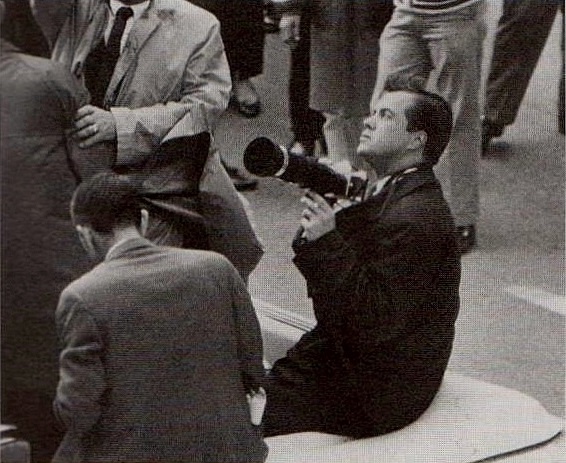 “Jackson had just his emptied camera with the telephoto lens on his lap and another camera on a strap around his neck, but as he later wrote, “It happened too fast, then, for me to get a photo of it’ (Richard Trask, Pictures of the Pain, page 440)
|
|
|
|
Post by Arjan Hut on Mar 16, 2019 11:09:38 GMT -5
68 One portion of (partially eaten?) fried chicken
"Evidence that William's lunch was interrupted?"  The 'sniper's window' in Hughes, seconds before the shooting The 'sniper's window' in Hughes, seconds before the shootingArnold Rowland was standing on Houston Street, about 150 feet from the Book Depository. He described a man holding a rifle thusly, "He had on a light shirt, a very light-colored shirt, white or a light blue or a color such as that. This was open at the collar. I think it was unbuttoned about halfway, and then he had a regular t-shirt, a polo shirt under this, at least this is what it appeared to be." (2WH171) ( ... ) The Warren Commission’s statement is true if by limited one means limited to the parts of the descriptions that fit Oswald. The testimony of one eyewitness in particular, Arnold Rowland, was especially relevant. Among all the witnesses who saw a gunman on the sixth floor, Rowland was alone in stating that he had seen the gunman on the west end of the building. In reading Rowland's testimony it is obvious that he was aware of the news reports that shots were fired from the window on the southeast corner. In that window, he insisted, he had seen another man; a man he described as an "elderly negro." The accuracy of Rowland's judgment of the time is unassailable. Rowland testified that about the time he saw the gunman in the window he heard the police dispatcher on a nearby motorcycle radio announce the time as 12:16 and that the motorcade was at Cedar Springs road near Turtle Creek. The police radio recording does show a broadcast that the motorcade was at Cedar Springs turning off Turtle Creek and the dispatcher does give the time as 12:16 (CE 1974, p. 159) The Warren Commission could not accept Rowland's detailed testimony and still infer that Oswald was in place in the sniper's nest for the thirty minutes preceding the assassination. It is obvious now that the "negro" seen by Rowland was a Book Depository employee named Bonnie Ray Williams.  Bonnie Ray Williams (left) and Harold Norman a minute after the shooting Bonnie Ray Williams (left) and Harold Norman a minute after the shootingExactly what Bonnie Ray Williams saw on the sixth floor that day is open to question. Williams was one of the four men working on the sixth floor that morning. He testified that when the crew went to lunch early that day they had agreed to return to the sixth floor to watch the President’s motorcade go by (3WH169). Williams retrieved his lunch from the Domino room, a “Chicken-on-the-bone sandwich.” He then went to the second floor lunchroom and bought a bottle of Dr. Pepper from the machine and took this meal to the sixth floor, evidently expecting to be joined by the other crew members. First issue: when was Williams on the sixth floor? According to his testimony, Bonnie Ray Williams arrived on the sixth floor with his chicken dinner and a soda-pop about, or shortly after, 12 noon. Williams testified that he neither saw nor heard anyone else on the sixth floor. As to when he left, Williams said, "I finished the chicken sandwich maybe 10 or fifteen minutes after 12. I could say approximately what time it was ... approximately 12:20 maybe." (3WH173; WR68) ( … ) The witnesses who arrived after Fritz saw the chicken lunch and pop bottle on the third aisle. All those witnesses who arrived ahead of Fritz saw the chicken bones scattered on the boxes in the sniper's nest. Deputy Sheriff Luke Mooney, the first person on the scene, was asked if he noticed a paper wrapper (the alleged gun case) lying near the window. He replied, "I did see this one partially eaten piece of fried chicken laying over to the right...It would be laying over on top of these other boxes..." (3WH286) "There was one of them partially eaten. And there was a little small paper poke" (3WH288) 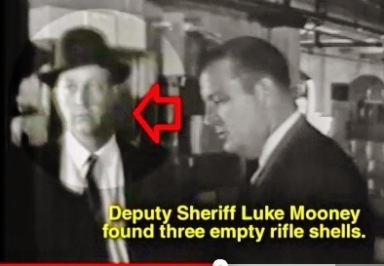 Patrolman E.D. Brewer was looking over Haygood's shoulder and testified that he saw next to the sniper's nest window a, "...paper lunch sack and some chicken bones or partially eaten piece of chicken, or a piece of chicken...a cold drink bottle, soda pop bottle." (6WH307) Day was asked what had become of these remnants and he answered that he had kept the sack and bottle but thrown away the chicken bones (4WH278). The testimony that the chicken was only partially eaten is evidence that William's lunch was interrupted. The fact is that the physical evidence coupled with the eyewitness testimony, indicates that Bonnie Ray Williams was in the snipers nest at 12:16 and probably later. Whoever the assassin was he could not have moved into place until a few minutes before the shooting. Yet, he must have been lurking somewhere on the sixth floor, perhaps on the west end of the building just as Rowland had testified. (excerpts from Rewriting History: Bugliosi Parses the Testimony by Don Thomas)
|
|
|
|
Post by Arjan Hut on Mar 17, 2019 5:20:27 GMT -5
69 Bullet found in JFK's limousine
Related:
63 7.65 shell found in Dealey Plaza on 12/02/63
64 Nearly whole bullet removed from JFK"Dear President Ford, I was active-duty Navy and assigned to the White House as White House Physician in 1963, when President Kennedy was assassinated… Knowing that you were on the Warren Commission at that time, I am writing to you confidentially, to see if you have any knowledge about an issue which has puzzled me for years… My particular problem is a description of what occurred at the autopsy. During the autopsy examination, Dr. Jim Humes, then the Chief of Pathology at Bethesda Naval Hospital, and two other pathologists stated that some pieces of President Kennedy’s skull bones were missing. In order to reconstruct the President’s head for burial, Dr. Humes wanted to find those pieces which were missing. Dr. Burkley and I requested two of our corpsmen who were assigned to our White House medical unit, to go to the Executive Office Building where the Secret Service had placed the “Queen Mary,” [sic] the open convertible in which President Kennedy had been shot, for bone fragments. Two of the corpsmen left and returned sometime later with three varying sized pieces of President Kennedy’s skull bones. In addition, they brought back in an envelope a spent misshapen bullet which they had found on the back floor of the “Queen Mary”[sic] where they had found the pieces of skull bones. The bullet and pieces of skull were given to Dr. Jim Humes. I have never seen anything written about that spent bullet in the Warren Report or elsewhere. Do you recall any testimony or comments which would clarify my concerns?" ( Excerpt from December 27, 2000 letter from James M. Young to Gerald Ford) 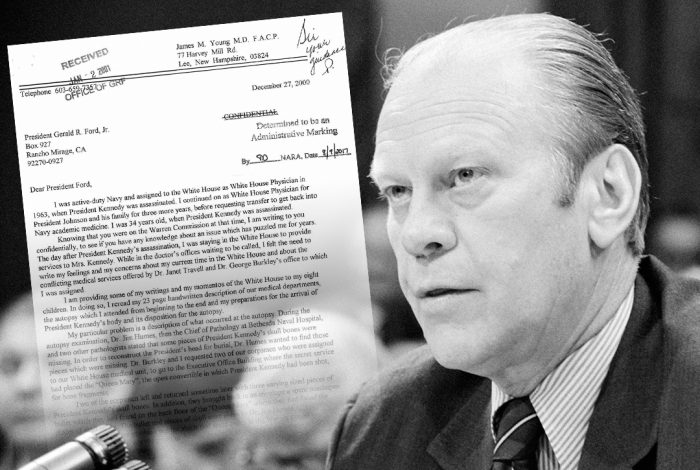 Gerald Fraud replied he did not remember any such bullet and referred Young to Gerald Posner's book Case Closed. Gerald Fraud replied he did not remember any such bullet and referred Young to Gerald Posner's book Case Closed.
|
|
|
|
Post by Arjan Hut on Mar 18, 2019 10:32:21 GMT -5
70 One piece of scalp“One of my pictures shows a policeman running toward the car with his .45 pulled, pointed right at my camera (and my head). ‘Get down!’ he yelled, ‘Get down!’ “By the time we had gone another 50 yards or so, we wanted out of the car. Our driver was scared stiff. We pounded on his back to stop the car. “Finally, he slowed down enough for some of us to peel off the back and sides. We hit the ground running. We raced back to the scene of the shooting. “I’ll never forget running along — with my camera going — yelling at the top of my lungs. ‘They can’t do it! They just can’t do it! You just don’t shoot the President!’ “The next moment, a woman came walking toward me slowly, crying her eyes out. Then a man ran past me, pursued by an FBI man. “At the scene, people were still lying on the ground, some protecting their children. Others were running. Policemen were scattering in every direction with shotguns and pistols drawn. “I started toward the building where I had seen the rifle in the window. Then I saw something very weird. There was a trail of blood from the spot where the shooting occurred to the entrance of the Texas School Book Depository. I pointed it out to a man with me. “Just then an FBI man stepped out of the building, and in his hand was an object dripping blood. It looked like a piece of hairy flesh. I know I didn’t imagine this. The scene is very clear to me. “I was also one of the few persons to see a small amount of brain matter near where the shooting had occurred. ( JFK Shooting Recalled Local Resident, Former TV Reporter Remembers Kennedy Assassination Couch’s Memories Remain Clear 37 Years Later, Clifton [Texas] Record, November 22, 2000)
|
|
|
|
Post by Arjan Hut on Mar 19, 2019 12:36:50 GMT -5
71 Jim Hood Photograph
Hood, Jim: Photographer for the Dallas Morning News, exposed several stills of a pool of blood located on the steps leading up to the grassy knoll. Within a few days, two FBI agents confiscated the prints and negatives which were never returned to the Dallas Morning News. (Weisberg Collection, Background Information on the Photographers) I recently ordered a book entitled Unsolved Texas Mysteries by Wallace O. Chariton. The reason being that it included an article on the Henry Marshall killing (very good it is to). However, there is another fascinating article by Chariton on how the FBI dealt with one aspect of the JFK assassination that was completely new to me. 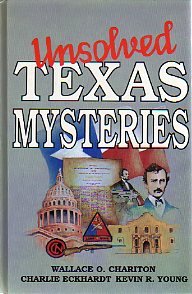 On the morning of the assassination, Jerry Coley, who worked in the advertising department of the Dallas Morning News, spent sometime drinking coffee with Jack Ruby, who had arrived at the office to place his weekly advert in the newspaper. Ruby spent far longer than usual in the office. He also seemed interested in looking at the Texas School Book Depository (the Dallas Morning News office provided a good view of the building). Coley and another worker from the building, Charlie Mulkey, decided to go and watch the JFK motorcade. Ruby said he was not interested in seeing JFK and remained in the office. Coley and Mulkey stood on Houston Street near the entrance of the old county jail. They therefore did not see or hear the shooting, however, when news spread to them they went to Dealey Plaza. While walking down the steps on the grassy knoll, they discovered a pool of blood (Mulkey actually tasted it to make sure it was blood). The two men estimated that there must have been a pint of blood on the steps close to the fence on the grassy knoll. When the two men returned to the office they told photographer, Jim Hood, about the blood. He visited the scene and took a photograph of it. Later that day, Coley showed the photograph to Hugh Aynesworth, an investigative journalist who worked for the Dallas Morning News. Aynesworth seemed interested in the story but it never appeared in the newspaper.  508 Young Street, the location of the Dallas Morning News building for six decades 508 Young Street, the location of the Dallas Morning News building for six decadesOn 25th November, 1963, Coley began receiving anonymous phone calls. The calls suggested that Coley was in someway involved in the plot to kill JFK. However, the real intention was to intimidate Coley into silence about the the blood on the steps. Threats were made against Coley’s children. The couple understandably decided to keep quiet about the story. In fact, Coley’s wife and their children went into hiding. When Coley returned to the steps on the grassy knoll, the blood had been cleaned away. On 27th November, 1963, a Time Magazine reporter arrived at the office. He wanted to interview Coley about the story but frightened about the consequences, he refused to speak to him. The following week, two FBI agents arrived at the office and asked to speak to Coley and Jim Hood. They asked to see the photograph. They took this away plus the negative. The FBI told the two men: “For your benefit, it never happened… Just forget the entire incident; it never happened.” (John Simkin, Education Forum, Posted February 12, 2006)
|
|
|
|
Post by Arjan Hut on Mar 19, 2019 13:52:12 GMT -5
72 Clint Peoples manuscript
See also:71 Jim Hood Photograph
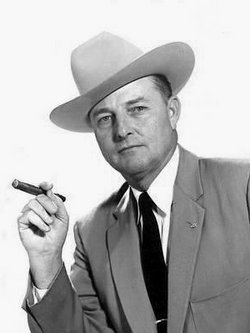
Peoples (1910-1992) was a lawman for 60 years including service as a Deputy Sheriff in Montgomery County,
27 years as a Texas Ranger, and US Marshal. He died when his vehicle veered off the road and hit a telephone pole.The men took this advice ( see 71.). However, in 1988, a film crew from Los Angeles contacted Coley and asked him if he would be willing to be interviewed for a documentary they were making on Jack Ruby. Coley agreed and during the interview he told them the story of the blood on the steps. The reporter was fascinated with the story and he was filmed at the spot where the blood was found. It was assumed by the reporter, that someone had been hit in the crossfire and therefore confirmed the view that there must have been two gunman involved in the killing of JFK. Three days later the reporter phoned to say that the director of the documentary had decided not to use the section on the pool of blood. Coley was relieved as his wife had complained when she heard that he had told the reporter the story. In 1990 Coley told the story to Wallace O. Chariton. He was convinced that Coley was telling the truth (by this time Hood and Mulkey were dead). Aynesworth was interviewed and he confirmed the story but claims that he was convinced that it was some sort of dark drink had been spilt on the steps. Coley was working on the Henry Marshall case at the time. He therefore asked Clint Peoples about the story of the blood on the steps. Peoples, who was carrying out his own investigation into the JFK assassination at the time, admitted that he already knew about the story. What is more, he believed it was an important factor in explaining the mystery of the assassination. What Chariton does not say in the article, is that Peoples claimed that he was on the verge of solving the case. He told several friends this at this time. Clint Peoples was killed shortly after Chariton’s book was published in 1991. His manuscript on the JFK assassination has never been found. (John Simkin, Education Forum, Posted February 12, 2006)
|
|
|
|
Post by Arjan Hut on Mar 21, 2019 11:23:20 GMT -5
73 Several Jim McCammon photo(s) and negativesSee also:82 James Powell's other 22-11-1963 Love Field/ Dealey Plaza photographsMacCammon. J.: PC: James MacCammon. Series includes the plaza after the assassination, the area of the Tippit shooting and the arrest of Oswald at the Texas Theater. What is interesting about these photographs is the fact that this series is very difficult to obtain. Only one photograph was obtained by the FBI which is the arrest frame of Oswald at the Texas Theater. ( Weisberg list of photographers) Jim McCammon - One of his photos, not yet found, may show the two men who were with Oswald when he was arrested. McCammon is now in New York and would testify to this. ( 1/10/68 letter from Harold Weisberg to Dick Sprague)  For a long time, this was the only known MacCammon photo For a long time, this was the only known MacCammon photoThe late Gary Mack in his 2013 An End to Conspiracy? TIME-article reasons that since there was a scuffle when Oswald was arrested, there should be no doubt that Oswald murdered Kennedy and Tippitt. Most interesting though is that with the article comes another MacCammon photograph, taken inside the Theater during the arrest. An excerpt: "But there's photograph that remains relevant and gripping five decades later, in a
different way, and relatively few have seen it. The picture was taken by Dallas freelance
photographer James "Jim" MacCammon barely 80 minutes after gunshots reverberated
through Dealey Plaza. MacCammon photographed 24-year-old Oswald as he emerged from
the Texas Theatre into the bright midday sun, sandwiched between Patrolman C.T. Walker
and, still chewing his cigar, Detective Paul Bentley.
Although MacCammon contacted news agencies, including LIFE, his remarkable photo went
unpublished until TIME ran it three months later in February 1964. Internal records show
that Time Inc. shared that picture and others MacCammon made with the FBI. Eventually,
in late 1964, three MacCammon photographs appeared in volume 20 of the Warren
Commission's documentation.
"It was always like a lecture," remembers Mary MacCammon, the photographer's daughter,
who was in the 4th grade at the time. "He always wanted us to know the story of what
happened when Oswald was arrested."
The MacCammon photo of Kennedy's assassin essentially disappeared for more than 40 years,
until the New York Times included it in Detective Bentley's obituary on July 27, 2008. The photo
credit line read, Jim MacCammon, courtesy of Howard Upchurch
But this time, unlike when TIME ran the photo in 1964, the picture appeared in color. Howard
Upchurch, a Dallas-area Kennedy assassination researcher, had befriended a man who in 1963
worked at MacCammon's favorite Dallas photo lab and kept a color print of the MacCammon
picture. Years later he gave it to Upchurch, who showed it to me in the 1980s and later loaned
it to The Sixth Floor Museum at Dealey Plaza.
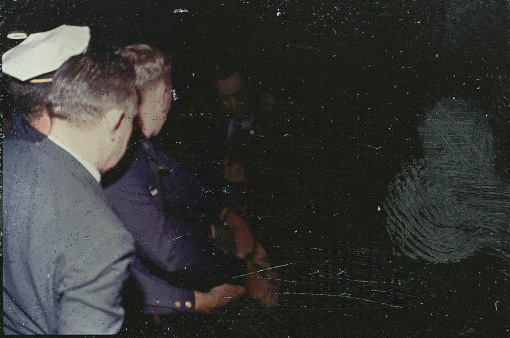 Moments earlier, as cops approached him, Oswald suddenly punched Officer Nick McDonald in the face, drew a revolver from his waistband and tried to shoot him. McDonald jammed his hand on the gun and prevented it from firing as other officers pummeled Oswald to the floor, sat him in a seat and cuffed him. (MacCammon took a picture of that moment, too, but the image is too dark to reveal much.) [ Ed's note: The TIME-LIFE Picture Collection discovered
several duplicate negatives in our search for MacCammon's photographs. We've reproduced
one of them below.]" (...) And now, as MacCammon heirs, who've only known about but do not possess his images, learn about and recover their father's unique documentation of the Kennedy assassination, we wonder what other revealing images are still awaiting discovery in someone's closet or scrapbook. (Gary Mack, November 22, 2013)
|
|
|
|
Post by Arjan Hut on Mar 22, 2019 9:23:56 GMT -5
74 Julio Fernandez' Oswald recordings and photos
Erasing the Past...DiscussionsOn the night of President Kennedy’s assassination, Clare Booth Luce, the wife of Time-Life publisher Henry Luce, received a telephone call from Julio Fernandez, a crew member of an anti-Castro Cuban attack boat that she financially co-sponsored with William Pawley. Pawley, a Miami multi-millionaire, staunch right-wing conservative and former owner of the Havana bus system and airlines before Castro, had helped General Claire Channault form the original Flying Tigers during World War II. He also served as U.S. Ambassador to Brazil and Peru, and persuaded Clare Booth Luce to help finance a fleet of motorboats that attacked Cuba like the Flying Tigers fought the Japanese. According to a Congressional Report, "Pawley envisioned them as Cuban ‘Flying Tigers’ flying in and out of Cuba on intelligence gathering missions." Luce agreed to sponsor one boat and its three-man crew, one of whom was Julio Fernandez. She met with her Cuban commandos in New York on three occasions and published a story about them in Life Magazine.  Clare Booth Luce (1903-1987) Clare Booth Luce (1903-1987)
She referred to them as "my boys," but until the night of the assassination, hadn’t seen or heard from them since the October, 1962 Cuban Missile Crisis, when the raids were said to have been discontinued. On the night of the assassination however, Julio Fernandez called Luce on the telephone and told her he had some information on Lee Harvey Oswald, the President’s alleged assassin. Luce claimed Fernandez told her that Oswald had approached the anti-Cuban group that Fernandez belonged to and offered his services as a potential assassin. "The Cubans however, didn’t trust Oswald," the report continues, "and suspected him of being a communist, and decided to keep tabs on him. They eventually penetrated Oswald’s ‘cell’ and tape recorded his talks, including his bragging that he could shoot anyone, even the Secretary of the Navy." Fernandez told Luce that Oswald came into some money, went to Mexico City and then Dallas. Fernandez said that he still had tape recordings of Oswald as well as photographs of Oswald and samples of the handbills he had distributed on the streets of New Orleans. Luce later said that she advised Fernandez to contact the FBI immediately, and didn’t think about the incident again until the Garrison investigation in 1967. She then recontacted Fernandez, and he told her that one of the members of his group has since been suddenly deported and that another had been murdered. He himself, wanted nothing more to do with the Kennedy assassination. When Congressional investigator Gaeton Fonzi tried to track down Fernandez, Luce said that "Julio Fernandez" may have been the Cuban’s "war name," like those used by Sylvia Odio’s visitors, "Angelo" and "Leopoldo," and the Congressional report concludes, "no such individual was ever found." But there is a Julio Fernandez, a suspicious suspect investigated by the Pennsylvania State Police and the FBI and whose records are published among the exhibits of the Warren Commission. This Julio Fernandez was a Cuban professional who may have known about an association between Jack Ruby and Lee Oswald before the assassination. ( see #75 A Pennsylvanian piece of paper) ( JFK Countercoup, Tuesday, January 1, 2008)
|
|





















 Clare Booth Luce (1903-1987)
Clare Booth Luce (1903-1987)